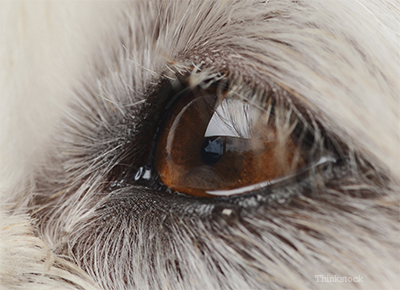Does your dog have “tear stains” on his fur? Have you ever wondered why? In order to understand excess tearing, it’s important to first review a little physiology 101.
What do tears do?
Tears perform a number of important roles: they lubricate the eye, provide a smooth optical surface, have antimicrobial properties, provide nourishment, and wash away debris. Baseline tears are produced at a constant rate, primarily to keep the eye lubricated. Reflex tears are triggered by any noxious stimulus, such as allergies, infections, foreign materials, hair, medications, and even dryness.
What causes excessive tearing?
Excessive tearing can be caused by one of two reasons:
Increased production
- Increased production of reflex tears may occur at higher volumes to “flush” an irritant away. In some animals, excessive tearing can be due to this increased reflex tearing.
Impaired drainage
- When excessive tearing is caused by impaired drainage, it is called epiphora. Tears normally drain via the tear ducts and ultimately empty into the nose. If there is a blockage anywhere along the course, tears will overflow.
So why does the lacrimal drainage system become blocked? Blockage can occur due to trauma, inflammation, medications, and rarely tumors. In certain breeds of cats and dogs, the problem is their anatomy. Breeds with flat faces (brachiocephalic) such as Boxers, Bulldogs, and Pugs, can have epiphora due to their flattened facial anatomy.
Symptoms of excessive tearing
Animals with excessive tearing have wet or moist fur below their eyes and may have other findings based on the underlying problem. If the tearing is chronic, animals develop a reddish brown stain below their eyes. The area may also be moist and their skin may become red and irritated.
below their eyes and may have other findings based on the underlying problem. If the tearing is chronic, animals develop a reddish brown stain below their eyes. The area may also be moist and their skin may become red and irritated.
Diagnosis of excessive tearing
If you think your pet has excessive tearing, you should take them to your veterinarian. Your veterinarian will determine if your pet has an underlying eye problem causing reflex tearing or a lacrimal duct obstruction. Excess tearing from conditions such as an infection, corneal abrasion, glaucoma, or foreign bodies are painful and need to be treated immediately. If the problem is from lacrimal duct blockage, the obstruction will have to be addressed. Your veterinarian will do a thorough eye examination to look for the underlying cause. They will also likely use fluorescein to evaluate for corneal abrasions or ulcers and to determine if tears are draining appropriately into the nasal cavity.
Treatment of excessive tearing
The treatment depends on the cause of excess tearing. If the problem is reflex tearing, the underlying trigger needs to be addressed. In dogs and cats, misdirected hair or eyelashes (trichiasis) is a common problem but the trigger could be allergies, medications, or an infection. If the problem is blockage of the lacrimal drainage system, the ducts may need to be flushed or the obstruction cleared with a surgical procedure to open the ducts.
Home remedies for excessive tearing
Remember, excessive tearing can be due to a serious underlying eye problem. So before you attempt any home remedies to address the tear staining on your pet’s fur, be sure your veterinarian evaluates your pet. There are no home remedies that have been proven to be 100% effective and some may actually be harmful to your pet’s eyes. Before you attempt to use any products around your pet’s eyes, speak with your veterinarian to make sure they are safe for your pet and appropriate for their particular condition.
If you have any questions or concerns, you should always visit or call your veterinarian -- they are your best resource to ensure the health and well-being of your pets.
